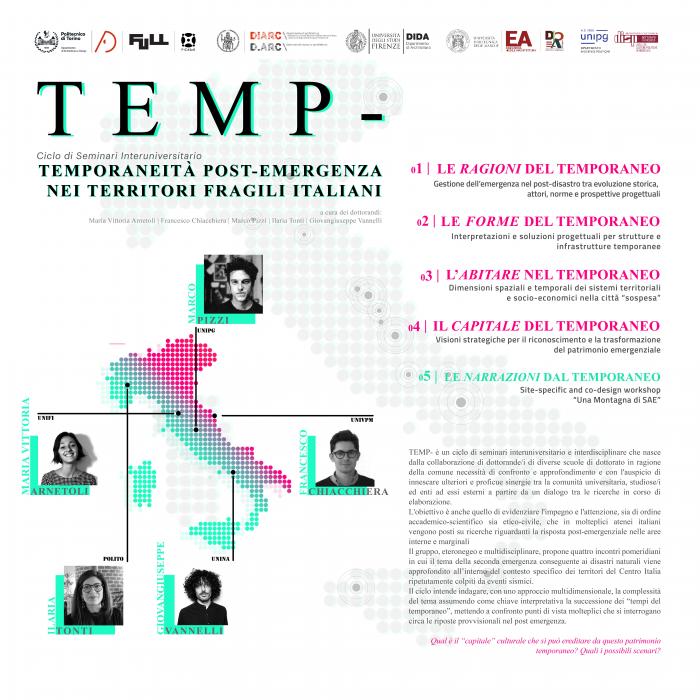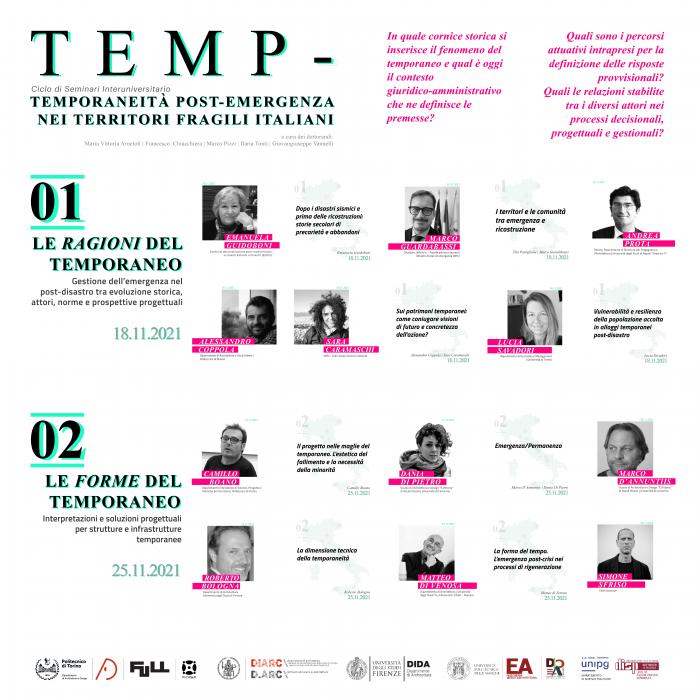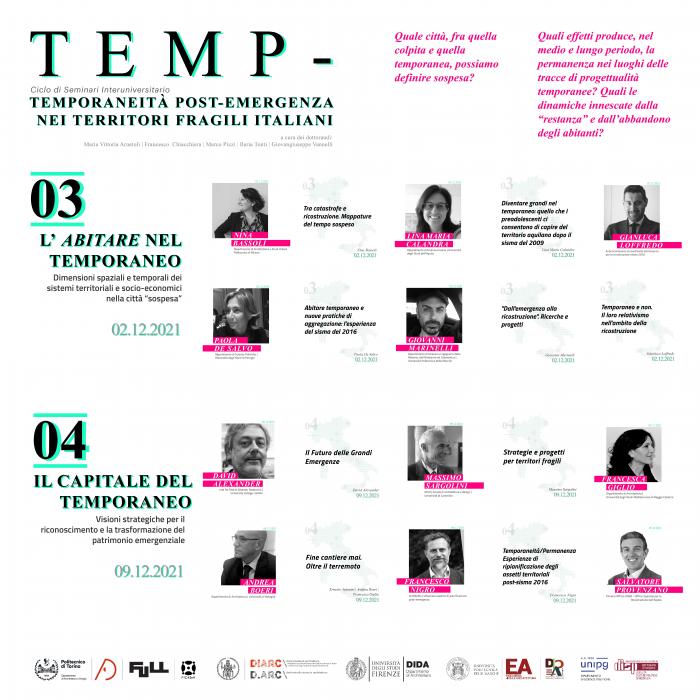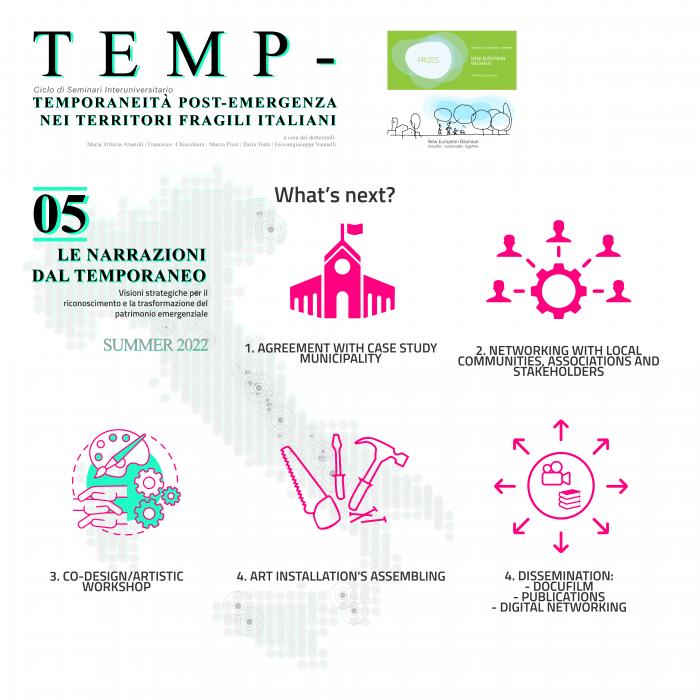The Italian interdisciplinary network of PhD students TEMP- proposes “A mountain of S.A.E.”: a collective action that involves communities affected by natural disasters in recognition of emergency structures as public assets. A disruptive artistic performance is proposed in one of the vulnerable and marginal small towns by simulating the acceleration of the natural process of ruination. This action demonstrates the necessity of re-thinking the design approach to temporary housing at its roots.
Our proposal moves from the cycle of seminars “TEMP- Post-emergency temporariness in fragile Italian territories” aimed to link different stakeholders involved in emergency management in Italy, and an interdisciplinary network of PhD students has organised it.The investigation assumes that an ever-increasing frequency and intensity of emergency phenomena causes destruction and a need for transitional houses. The impacts of local phenomena (earthquakes, floodings, fires) overlap with global ones (climate change, migrations, pandemics). The relationship between ordinary and extra-ordinary determines a condition of permanent emergency, status highlighted by COVID-19. The multidimensional character of these challenges requires a new approach towards emergency. The proposed idea operates in the Italian context in which the absence of a strategic and preventive vision causes the permanence of “temporary” solutions. In marginal small towns, this exacerbates pre-existing vulnerabilities and inequalities. Our long-term objective is to trigger the practical effects of what has been investigated in the academic field. Therefore, “a mountain of S.A.E.” (Soluzioni Abitative Emergenziali - Housing Emergency Solutions) intends to “unveil” the potential value of temporary structures as a public “capital” - so far unrecognised - through a disruptive action dealing both with architectural and artistic dimensions and foreseeing public engagement and inhabitants involvement. A depopulating small village with vacant temporary structures will be identified as the stage hosting the performance. The proposed public art project will involve both the former affected inhabitants and universities, dismantling a housing emergency solution as an exploratory moment. Thus, "a mountain of S.A.E." is an installation consisting of a pile of con-temporary rubble that accelerates a feasible process of ruination, triggering a broader reflection on the concept of reuse, recycling of temporary components.
Please highlight how the concept/idea can be exemplary in this context
Post-emergency structures today have huge environmental impacts, both in terms of primary resources consumed - firstly the soil - and in terms of components produced. Once they reach their degree of obsolescence, these structures will be disposed of with unsustainable end-of-life. In addition, as the housing modules will be dismantled, the wide foundation platforms will remain as a wound in the landscape. This “temporary capital” thus becomes a permanent problem.
In order to look at post-disaster structures as a potential resource, it seems to be necessary to overcome the current model by moving towards a long-term circular vision that deals with the role of temporary structures during the progress of reconstruction until its conclusion.
This approach is even more urgent in small marginal centres, where it is necessary to avoid further waste of resources and investigate how to make the most of what already exists. It is necessary to re-imagine design commissions by understanding the limits of the solutions adopted until now. “A mountain of S.A.E.” will operate on the inherited structures to recognise their possible potentialities in a circular perspective or, alternatively, to demonstrate the impossibility. Reuse and recycling are assumed as theorems here demonstrated by proof of contradiction. Beyond space, time is the dimension to be questioned. If the dismantling action does not allow the recovery of materials and components that can be reused in other projects and processes, then the proposed operation is an acceleration of the phenomenon of ruination.
In this way, the intention is to activate a process of renaturation by enhancing biological processes of recolonisation through a performance that intentionally makes manifest the lack of alternatives to the status of ruins. So, the artistic performance expands in time until it becomes a parallel process to the slow ruination. Ultimately we propose an evolutive landscape beyond the ongoing geography of waste.
Please highlight how the concept/idea can be exemplary in this context
Two issues are taken as premises: the term "aesthetics" - from the greek - refers to what is "perceived through the mediation of senses", while the concept of "beautiness" - proposed by TAM Associati architect Raul Pantaleo - has a generative and design capacity that beauty does not have.
On these two assumptions, the project intends to fit into the marginal contexts to which we are referring as an aesthetic operation that makes visible something that is not directly perceptible through the senses, namely time.
Touching the "time" of these architectures is a complex activity requiring an artistic dimension that allows communities, academics, and institutions to perceive it. The aesthetic value, therefore, lies in the performative act of unveiling.
The process of dismantling temporary housing becomes both an act of knowledge and catharsis, a liberating action. It is an experience that goes beyond the limits of the moment in which it takes place since the assumption of awareness and the knowledge generated by the performance become useful mediums for recognising the beautiness in that temporary capital both in the short and long term.
“A mountain of S.A.E.” acts as a warning: temporary legacy must urgently be understood as a resource and not as waste. Where past planning has not foreseen the possibility of reusing structures, if not by re-functionalization - although the current depopulation rarely defines the necessary premises in most of these contexts - it seems that the only possible future is ruination. The proposed action accelerates this process and intends to build a new landscape through the renaturation of this contemporary rubble.
This public artwork intends to work on both the signified and the signifier to make manifest on the one hand the need for a metabolic vision in these landscapes and on the other the possibility of recognising a public capital in these temporary endowments.
Please highlight how the concept/idea can be exemplary in this context
Today, post-emergency management is negatively characterised by a sectoral approach that prevents the different actors involved from collaborating during the process and citizens from being actively involved in the choices.
The interdisciplinary network TEMP- was born from the desire to trigger a sharing of approaches as holistic and inclusive as possible, based on the networking of five PhD students from different universities who share common research interests.
In line with these principles, the idea presented here proposes unconventional forms of interaction between different actors (universities, public institutions, inhabitants, associations) by adopting innovative practices of citizen engagement, which can guide the reflections initiated in the cycle of seminars towards the construction of possible and alternative future scenarios.
Specifically, a bottom-up artistic action is proposed as a trigger for structural changes in the system. The temporary phenomenon - silent but widespread and multiform in Italy - is brought to attention, putting tension in a necessary public debate.
While the seminar cycle, although with strong innovative and original features, adopted a traditional theoretical academic approach, here the intervention is practical, and we aim to operate in the study context.
The participatory and artistic “worksite” for manipulating a temporary module, which has never before been tried out in this way of involving inhabitants, students, administrators, designers and planners, assumes the value of denouncing what has been realised with public resources, triggering paths of knowledge, training and education in relation to post-disaster architectures.
To be highlighted is the direct involvement of a municipal administration that will be a partner in the project. A village in Central Italy in a strong state of depopulation will be identified to develop the public artwork using manipulable housing units.
Please highlight how this approach can be exemplary
The current regulatory processes governing the provision and management of temporary structures are extremely complex, making it difficult to introduce change formally.
By its experimental character and unconventional models of actors' involvement, the proposed action intends to initiate a discussion on the concepts of "temporary" and "temporary living", seeking new meanings.
The three dimensions of sustainability, beauty and inclusion are integrated into the project through the artistic language to build a participatory and creative action on temporary public capital. The investigation about a potential circularity of the temporary intervention is carried out through an inclusive action among multilevel actors, and it finds in the collective performative act its aesthetic value. The deconstructing provocative act of a prefabricated module through co-design could trigger the development of a sense of (unreflective) awareness of the irreversible impacts of this phenomenon, with the aim of fostering future alternatives to this model of action.
"A mountain of SAE" echoes Mimmo Paladino's work "A mountain of salt" located in Gibellina, and the previous is an inclusive and metabolic reinterpretation of the latter. This waste - a large number of temporary structures - cannot be reused. Art goes beyond functionality through its experiential and, therefore, aesthetic value, understood as a process of communication and perception through the senses. The objective is also multi-level. The first level is related to the awareness that we want to create in the citizenship, sometimes unaware of what temporary housing is made of; a second one is demonstrative and highlights the opportunity lost to the institutional authorities. A third level intends to draw attention to other critical elements of temporary settlements: lack of relationship with the context, low flexibility of structures, poor humanisation of spaces.
As stated above, the disused or underused legacy of "temporary" architecture, a widespread phenomenon throughout Italy, repeatedly affected by natural disasters, and in a "shadow" position concerning reconstruction, has highlighted how the sectoral emergency approach has proved inadequate to deal with the complexity of the current polycrisis. Although the primary intention of the TEMP- group is to trigger innovative forms of multi-level dialogue, the innovative character of the proposal lies in the construction of unconventional models of research and action with the territories. With a voluntary and collective practical action on physical structures, through the medium of performative and collective artistic practice, a theoretical and physical deconstruction of the concept of the temporary is proposed to denounce hidden evidence and become aware of its individual material components. Dismantling the module, where possible, into its components and then re-organising them in the form of an abacus of elements and materials makes it possible to understand what the module is made of and to assess the real possibilities of reuse and re-utilization.
The role and approach of the TEMP team of researchers is not positivist or resolving a phenomenon that has proved difficult to change in the last few decades. However, it does propose a participatory action of rupture that can leave a recognisable and sculptural mark on the territory and make explicit what is hidden behind the illusion of temporariness. Innovative is not only the idea of collectively manipulating a public asset that has reached the end of its life, but also the action of reflecting together on a second life cycle, anticipating through the artistic installation an otherwise inevitable process of ruination. A critical and systemic observation of temporary capital is proposed through the lens of intersecting value perspectives: artistic, circular or simply memory.
Since the cycle of seminars held in November and December 2021, the National Research Network TEMP- intends to promote projects and research in post-emergency marginal contexts.
The proposal identifies three temporal steps for future developments:
- Short-term goals: promotion of the TEMP- network and, in summer 2022, the realisation of the public art project "a mountain of SAE". The aim is to expand the network of relations structured through the cycle of seminars and to root it in the territories with local actors and institutions.
- Medium-term objectives: drafting a publication collecting the contributions proposed by the participants in the TEMP- the cycle of seminars. Production of a docu-film describing the performative action "a mountain of SAE" in its dimension of public art that brings together the voices and views of the actors involved. These actions should summarise the extension of the network and its capacity to propose shared project visions.
- Long-term objectives: Through the "a mountain of SAE" project, it is intended to make a disruption in currently established practices, encouraging the identification of new paradigms for the process and design of future temporary responses.
In this framework, the construction of an open-source digital platform on a national scale as an archiving device for knowledge and projects is placed. "Temporary Italy" would be shown in its projects and transformations to demonstrate how complex is this inherited capital, which sometimes can even constitute new renaturalised landscapes. Lastly, in continuity with the construction of the single text for reconstruction in Italy, coordinated by the commissioner structure of the Ministry of the Interior, the ultimate aim is to lay the basis for a preparatory study for the elaboration of an equivalent single text on post-emergency temporariness, not only of a regulatory nature but also aimed at re-imagining and redesigning provisional legacy.
In this first year, the programming of activities could address both short-term and medium-term objectives in order to lay the basis for a broader long-term research work aiming at the construction of a national platform on post-emergency provisioning capital. More specifically, the TEMP- team will first organise the artistic performance "a mountain of SAE" (July 2022). In collaboration with national and local institutions, a municipality will be identified in relation to the characteristics described above (high depopulation, abandonment of temporary structures, lack of planning). Preparatory activities for the workshop will be carried out before (June 2022): contacting the municipality, agreeing on usable space, identifying a module to be dismantled, promoting the event among the population, local and national administrators, university students. It is emphasised that we intend to involve artists in the dismantling process of the module through multidisciplinary collaboration. As part of the process of promoting and implementing the project, other researchers will be involved to consolidate the interdisciplinary networking that was a prerequisite for setting up TEMP-. Among others, support will certainly be sought from environmental engineers who can contribute to the proper management of the renaturation process: a sustainable intervention strategy that can bring beauty back to a place that has been deprived of it due to the disaster. Following the development of the art workshop, we will produce a documentary that will give back the performance experience (September-November 2022) so that it can be divulgated through multiple channels of communication. Through it, we will participate in festivals of art and regeneration of small towns (e.g. Borghi in festival MIBACT). In parallel, throughout the year, we will be working on publishing the seminar series and a call for papers aimed at expanding the temporal network.
@Tonti, 2022
Content licensed to the European Union.




